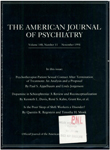The diagnostic implications of formal thought disorder in mania and schizophrenia: a reassessment
Abstract
The authors compared nine manic patients exhibiting formal thought disorders (tangentiality, neologisms, drivelling, private use of words, and paraphasias) with 102 manic patients without these thought disorders and with 31 schizophrenic patients. Manic patients with formal thought disorders tended to have more "schizophrenic" symptoms than did manic patients without formal thought disorders, but both groups improved significantly more during the index episode than did the schizophrenic patients. Although the prevalence of flight of ideas was high in mania, narrowly defined formal thought disorder was rare, suggesting that precise definition and description of thought disorders would be helpful in distinguishing mania from schizophrenia.
Access content
To read the fulltext, please use one of the options below to sign in or purchase access.- Personal login
- Institutional Login
- Sign in via OpenAthens
- Register for access
-
Please login/register if you wish to pair your device and check access availability.
Not a subscriber?
PsychiatryOnline subscription options offer access to the DSM-5 library, books, journals, CME, and patient resources. This all-in-one virtual library provides psychiatrists and mental health professionals with key resources for diagnosis, treatment, research, and professional development.
Need more help? PsychiatryOnline Customer Service may be reached by emailing [email protected] or by calling 800-368-5777 (in the U.S.) or 703-907-7322 (outside the U.S.).



